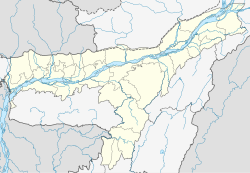The Arthashastra is an ancient Indian Sanskrit treatise on statecraft, economic policy and military strategy. Kautilya, also identified as Vishnugupta and Chanakya, is traditionally credited as the author of the text. The latter was a scholar at Takshashila, the teacher and guardian of Emperor Chandragupta Maurya. Some scholars believe them to be the same person, while most have questioned this identification. The text is likely to be the work of several authors over centuries. Composed, expanded and redacted between the 2nd century BCE and 3rd century CE, the Arthashastra was influential until the 12th century, when it disappeared. It was rediscovered in 1905 by R. Shamasastry, who published it in 1909. The first English translation was published in 1915.

Balasore or Baleshwar is a city in the state of Odisha, about 194 kilometres (121 mi) north of the state capital Bhubaneswar and 152 kilometres (94 mi) from Kolkata, in eastern India. It is the largest city of northern Odisha and the administrative headquarters of Balasore district. It is best known for Chandipur beach. The Indian Ballistic Missile Defense Program's Integrated Test Range is located 18 km south of Balasore.
Kamrup Rural district ; is an administrative district in the state of Assam in India formed by dividing the old Kamrup district into two in the year 2003; other being Kamrup Metropolitan district, named after region it constitute. The district, along with Nalbari, Barpeta, Kamrup Metropolitan, and Baksa districts have been created from the Undivided Kamrup district.

Kamarupa, an early state during the Classical period on the Indian subcontinent was the first historical kingdom of Assam.

Shantipur is a city and a municipality in the Ranaghat subdivision of Nadia district in the Indian state of West Bengal. The fort area of this city, also known as Daak-Garh is thought to have been built by Raja Krishnachandra of Nadia.

Barpeta is a town in Barpeta district of the state of Assam in India and is district headquarters. The city is located 90 kilometres (56 mi) north west of Guwahati and is one of the major cities in Western Assam. It is also called Satra Nagari of Assam due to the presence of various Vaishnavite Satras in the vicinity.

Nalbari is a town and a municipal board in Nalbari district in the Indian state of Assam. Nalbari town is also the headquarters of Nalbari District.

Tihu (Pron:ˈtɪhuː) is a town and a town area committee established in 1951 in Nalbari district in the Indian state of Assam.
The ancient name of Tihu was 'Dihu'. According to Kalaguru Bishnu Prasad Rabha, 'DI' means 'water' and 'HU' means 'flow'. 'Dihu' is actually a word of Bodo language. The ancient name of the town came from the name of the river 'Dihu', which flows through the heart of Tihu Town. According to Assamese scholar, Banikanta Kakati, the name of the river transformed to 'Tihu' as time passed by. So the name of the town too changed to 'Tihu'.
Assam silk denotes the three major types of indigenous wild silks produced in Assam—golden muga, white pat and warm eri silk. The Assam silk industry, now centered in Sualkuchi, is a labor-intensive industry.

Batsor, also Batshar and Batchar is a village in Nalbari district of the Indian state of Western Assam. It is surrounded by Belsor, Churchuri and Goalpara.

Lower Assam is a region situated in Western Brahmaputra Valley encompassing Kamrup and Goalpara regions.
The Koch Rajbongshi(also Rajbanshi) is an ethnic group inhabiting parts of Assam, Meghalaya, northern West Bengal,some parts of Bihar and on the eastern parts of Nepal, Bhutan and northern Bangladesh.

Baihata Chariali is a town in Kamrup Rural district of Assam, India; situated at norther site of the river Brahmaputra.

Chaygaon is a town in Kamrup district of Assam, India; situated on the south bank of the Brahmaputra river. It is 36.8 km from major town Guwahati. The town is known for "Maa Chandika Devalaya", a Shakti Peeth, where thousands of devotees visit during Durga Puja. Historical "Mer Ghar" of Chand Sadagar situated in Champak Nagar, Chaygaon.

Kamrupi dialects are a group of regional dialects of Assamese, spoken in the Kamrup region. It formerly enjoyed prestige status. It is one of two western dialect groups of the Assamese language, the other being Goalpariya. Kamrupi is heterogeneous with three subdialects— Barpetia dialect, Nalbariya dialect and Palasbaria dialect.

Undivided Kamrup district is a former administrative district located in Western Assam from which Kamrup Rural (2003), Kamrup Metropolitan (2003), Barpeta (1983), Nalbari (1985) and Baksa (2004) Kamrup South (2015) districts were formed. It was announced in January 2020 that the Bajali sub-division of Barpeta district will be upgraded to a full district.

Purna Daichapra is a village of Nalbari district in Western Assam. This village is situated in the border of Nalbari and Kamrup District.
The Kamrupi people are an linguistic group that speak the Kamrupi dialects of Assamese and are found in the colonial Kamrup district region of Assam, India.

Kalardiya, also "Dohgaon Kalardiya" is a village in Kamrup rural district of Western Assam. It is located at south bank of river Brahmaputra.










